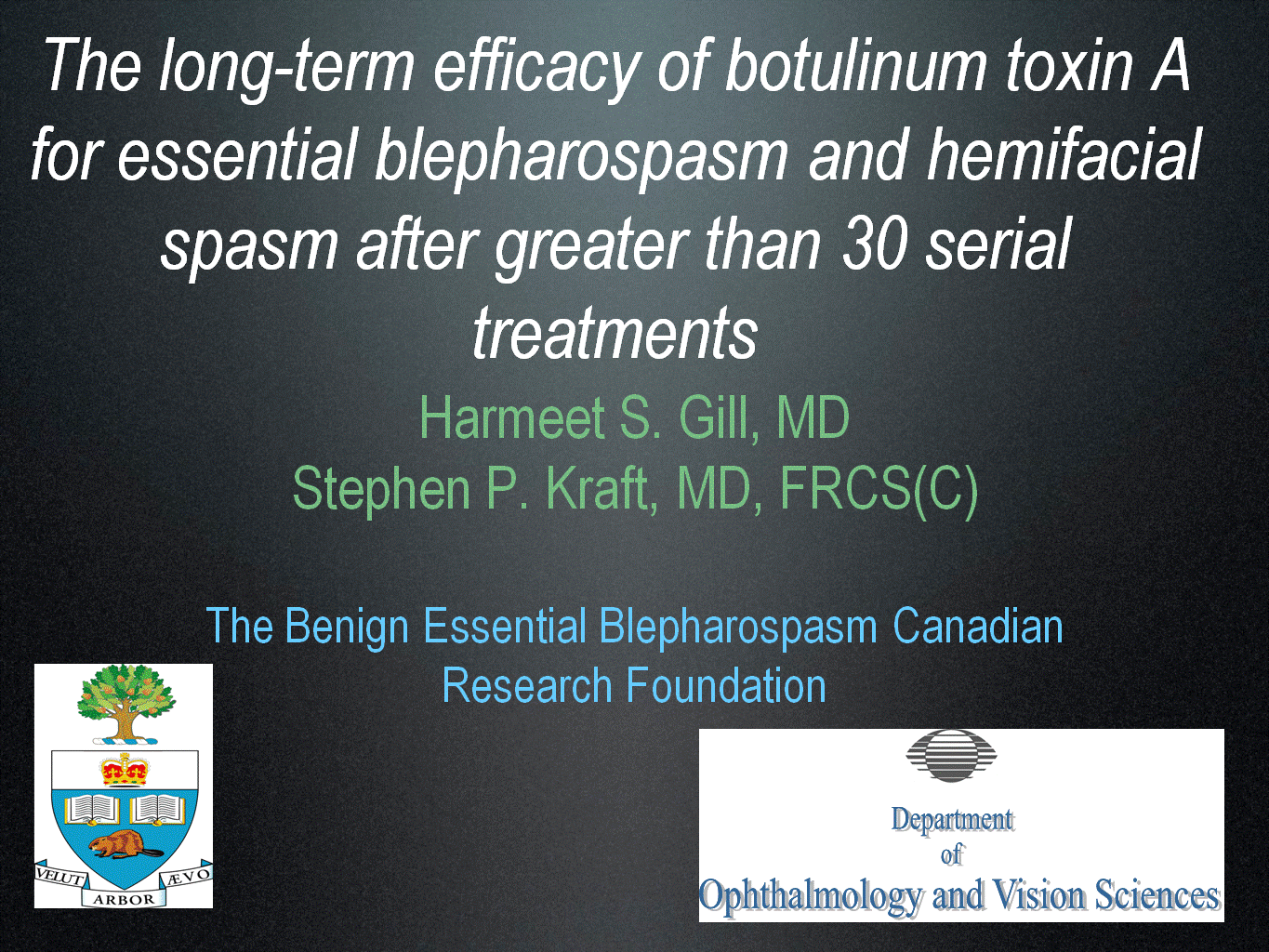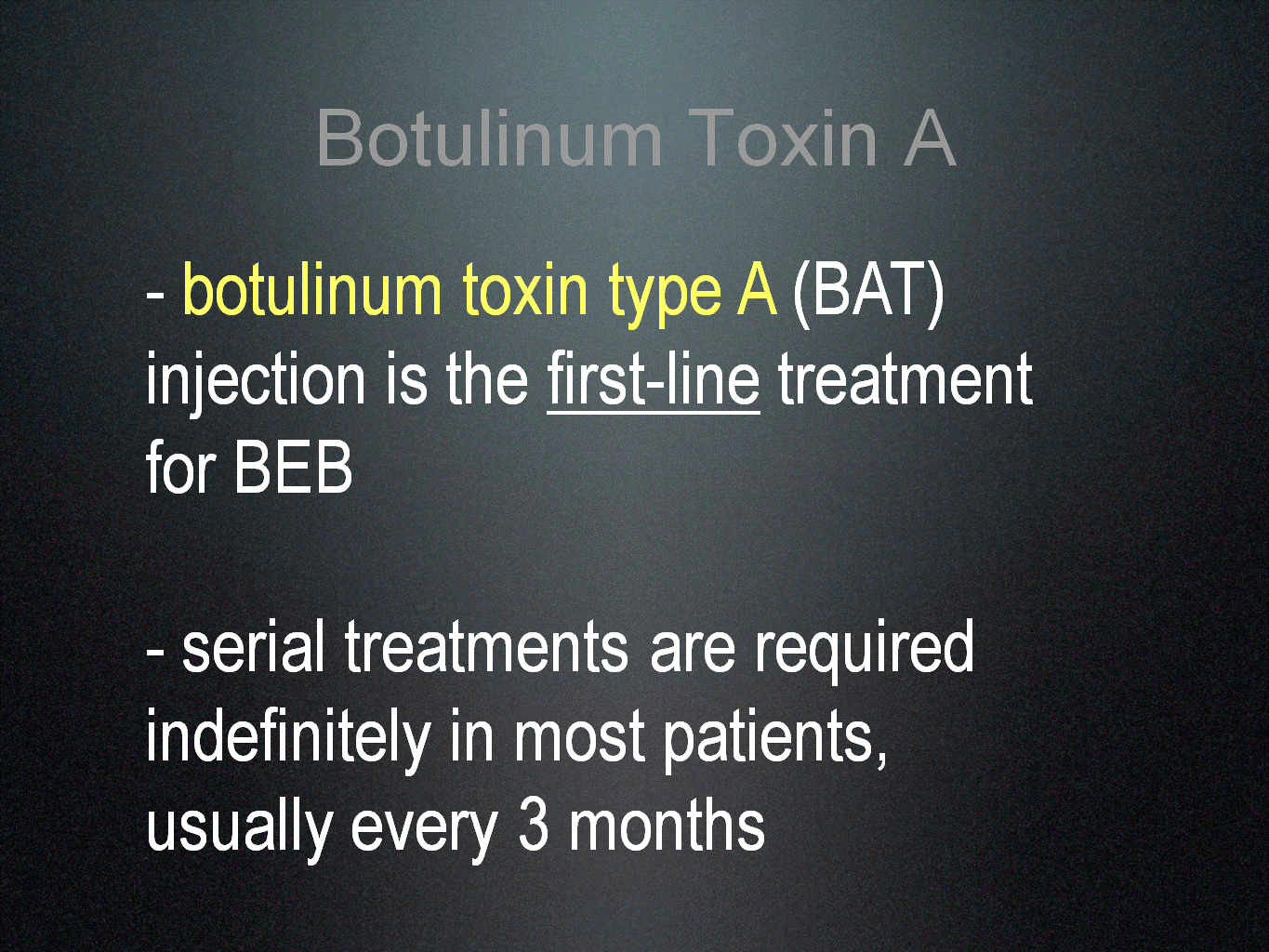BEBCRF Support Group Meeting – Toronto, Fall 2007
Treatment of blepharospasm with botulinum neurotoxin type A: long-term results
Presenter:
Dr. Harmeet Gill

The purpose of the study is to determine whether the duration of relief from symptoms, after 30 plus treatments with BOTOX® increase, decrease or remain the same. If you look at other studies in the current literature, there are conflicting reports.

Some theorize that you end up with a little less of the toxin because the muscle becomes atrophied and so on. Whereas, other studies report that you get sensitized to the drug and you end up needing more of the toxin with time. Still others state that nothing changes and that the effect is constant. The object of the study is to help us better understand what is really happening.

Both Benign Essential Blepharospasm (BEB) and Hemifacial Spasm (HFS) fall into the category of facial dyskinesia - a debilitating disorder characterized by involuntary spasm of the periocular and facial musculature. BEB is a diagnosis after exclusion, that is, when you rule out such secondary symptoms as dry eyes, etc., as the cause of the involuntary spasms.
However, with BEB the cause is thought to be a degenerate change in the basal ganglia; a part of the brain which handles co-ordination. Parkinson's disease is also the result of such a degenerative change.

BOTOX®, currently, is the first line treatment for BEB whereas this was not the case 20 to 30 years ago when there were more aggressive treatments such as a full myectomy, and, from a neurological point, various forms of oral medications. In the majority of cases, serial treatments of BOTOX®, are life-long and are repeated every three months, although this may vary.
In Terms of where the injections are done the muscle involved is called the orbis occularis (a, b, c, d) and it is the muscle that allows us to blink.

There are different parts of it: the preseptal portion is the outer part (e, f) and the inner part (g, h) is the pretarsal. Normal involuntary blinking, every 7 or 8 seconds, is brought on by the preseptal and pretarsal muscles. If you were to get soap in your eyes and you wanted to squeeze down hard you would use the orbital muscle. Some physicians will inject in the pretarsal portion, some in the preseptal muscle and, still others in some combination of both. Physicians will also inject in the orbital muscle if they deem it necessary.
The main research question of this study is does the benefit of BOTOX®, in relieving spasm change over time.

There are also a series of secondary criteria that has to be examined. How many patients, during their treatment period, needed an increase in the dosage and at what period of time? For example, was the increase in the dosage after 10, 20 or 30 injections? Subsequent criteria to be examined are did the intervals of relief change over time and how many patients stopped responding to the injections and required surgery. Finally, does age, gender, the intensity and duration of the disease prior to initial treatment play a mitigating role in all of this?
The study is a retrospective one examining patients over a long period of time without any breaks in the treatments. The primary variable is the actual number of BOTOX®, treatments and the duration of relief from spasms measure in weeks is the important outcome.

The answers to the secondary questions will also follow from the study.
The study will review the medical records of Dr. Stephen P. Kraft and select all those patients who were consecutively treated between 1985 and 2007 and who received 30 or more BOTOX®, treatments for BEB and HFS.

All patients will have had a complete ophthalmologic eye exam before treatments, and, HFS patients will have undergone the necessary neuro-imaging to rule out intracranial causes such as tumours, etc. Patients with such secondary causes of blepharospasm as blepharitis, dry eye syndrome, trichiasis, etc., or, who have had eyelid surgery, etc. will be excluded.

Blepharitis refers to inflammation of the eyelids, particularly at the lid margins. It's a common disorder and may be associated with a low-grade bacterial infection or a generalized skin condition.
Trichiasis is a condition of abnormally long or misdirected eyelash growth. As a result, the lashes may rub the cornea and lead to a red, painful eye or corneal abrasion and ulceration.
Uvetis is inflammation inside the eye, specifically affecting one or more of the three parts of the eye that make up the uvea: the iris (coloured part of the eye), the ciliary body (behind the iris, responsible for manufacturing the fluid inside the eye) and, the choroid (the vascular lining tissue underneath the retina.
The patients will be divided into two groups,BEB and HFS, and, each group will be analyzed independently. All secondary criteria such as age of first injection, number of treatments and so on are also analyzed independently.

The study will examine all cases with a high rating on the Jankovic scale. Only patients that have had a grade 2 or higher rating on the scale prior to their initial treatment will be considered.

The duration of relief will be defined as the time from the injection to the next occurrence of symptoms, that is, when the patient feels that a repeat injection is warranted, measured in weeks. This is not necessarily the time measured between the actual injections but rather when the patient indicated that he or she was due for another injection. Dr. Kraft’s excellent records indicate this in the majority of his patients.
The first treatment for a patient is not necessarily the first few injections or patriation time where the base dosage is determined but, rather, the injection that provided a minimum of thirty symptom free days.

Statistics is a type of mathematical analysis involving the use of quantified representations, models and summaries for a given set of empirical data or real world observations. Statistical analysis involves the process of collecting and analyzing data and then summarizing the data into a numerical form.
In statistics, a linear model is one in which the value of a parameter for a given value of a factor is assumed to be equal to a + bx, where a and b are constants. The model predicts a linear regression.

The term trend analysis refers to the concept of collecting information and attempting to spot a pattern, or trend, in the information.
Confounders or variables will have to be examined in order to get very clean data.

The results of the study will be presented to the American Academy of Ophthalmology in November of 2008. The assistance provided by the Foundation's members will be documented as part of the study.

BOTOX® is a registered trademark of Allergan Corporation

